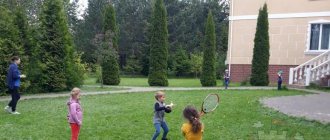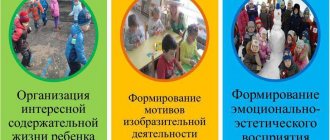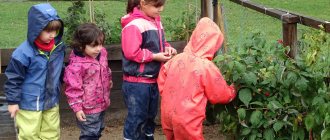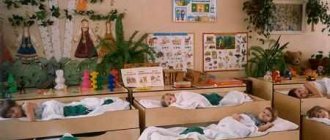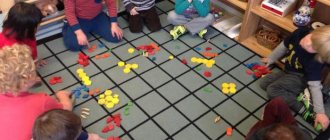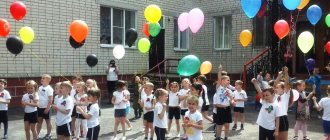Story-based outdoor games for preschoolers
Story-based outdoor games for preschoolers help children consolidate their knowledge and ideas about objects and phenomena of the world around them. For example, about means of transportation (cars, trains, planes) and the rules for using them; about the habits and characteristics of the movements of various animals and birds, etc.
Outdoor game for preschoolers “birds in nests”
As many children can be involved in this outdoor game as the area of the game allows.
So, the children sit on chairs placed in the corners of the room. These are the “nests”. At a signal from an adult, all the “birds” fly to the middle of the room, scatter in different directions, crouch down, “looking for food,” and fly again, flapping their arms and wings. At the signal “Birds, go to their nests!” the kids should return to their seats. It is important that children act on a signal, fly away from the “nest” as far as possible and return only to their “nest”.
This active game for preschoolers can also be played outside. Then the “nest” will be a circle drawn on the ground, in which the child must squat.
Outdoor game for preschoolers “mice and cat”
Children sit on benches or chairs. These are “mice in holes.” On the opposite side of the room or area sits a “cat”, whose role is played by an adult. The “cat” falls asleep (closes his eyes), and the “mice” scatter throughout the room. But then the “cat” wakes up, stretches, meows and begins to catch “mice”. The “mice” quickly run away and hide in holes (take their places). The cat takes the caught mice home.
Outdoor game for preschoolers “train”
Children stand in a column one at a time, without holding each other. The first child is a locomotive, the rest are carriages. The adult blows the whistle, and the “train” begins to move forward, first slowly, then faster, faster, and finally the children start running. After the adult says, “The train is approaching the station,” children should gradually slow down and then stop. Then the children are invited to go out for a walk, pick flowers and berries in an imaginary clearing. And at the signal to form a convoy again, the train begins to move.
During the game, children can demonstrate the colors of the traffic light - to do this, just cut out colored circles and flags and adjust the movements of the train according to the color of the traffic light.
Outdoor game for preschoolers “fisherman and fish”
A large circle is drawn on the floor or platform. One of the players - the “fisherman” - is in the center of the circle, he squats down. The rest of the players, the fish, circle around the circle and say in unison: “Fisherman, fisherman, catch us on a hook.” At the last word, the “fisherman” jumps up, runs out of the circle and begins to chase the fish, which scatter all over the site. The caught “fish” itself becomes a “fisherman” and goes to the center of the circle.
Plotless games, outdoor games for preschoolers
Such outdoor games for preschoolers teach children to act quickly on a signal, develop dexterity, attention and ingenuity, and the ability to navigate in space.
Outdoor game for preschoolers “Catch Me”
The child is sitting on a chair at one end of the room, and you invite him to catch up with you and run to the opposite end of the room. When the baby runs up to you, stop and say: “Run, run, I’ll catch up!” The little one runs back to his place.
Remember that during this active game for preschoolers you should not run away from the child too quickly, because he is interested in catching up with you! Also try not to catch your baby too quickly, so that he does not fall, get scared and lose interest in the game.
An outdoor game for preschoolers “don’t be late”
An adult places multi-colored cubes or other toys on the floor in a circle. These are chips. The children each stand at their own toy. At a signal from an adult, they scatter throughout the room, and at the command “Don’t be late!” run back to the chips.
Everyone is in a hurry, and no one should be late. Initially, during this outdoor game, preschoolers can run up to any free cube, but gradually they get used to taking their place. When repeating the game, you can invite the kids to run “like horses”, raising their knees high, or “like mice” - quietly, on their tiptoes.
Outdoor game for preschoolers “find an object”
To conduct this active game for preschoolers, you need to place small objects throughout the room in various places. These can be cubes, small cars, rings from a pyramid. The task for the child is to find all the toys as quickly as possible.
Outdoor fun games for preschoolers
These outdoor games for preschoolers are designed to be fun. They improve mood and are able to amuse and distract children.
Outdoor game for preschoolers "blind man's buff"
The venue for the game is a spacious room or a clean courtyard. One of the participants - the driver - is blindfolded (or put on a bright cap or cap, pulling it down so as to close his eyes), after which he, carefully moving around the room by touch, must catch one of the other players.
When playing this game for preschoolers, the driver can also be an adult. In this case, his goal is not even to catch, but to amuse the kids.
Action and story games
Author: Pivnyk Yulia Yurievna
MOVEMENT AND STORY-STAGED GAMES
It is very important at an early stage of childhood to lay the foundations of positive artistic perception, to raise our kids to be dexterous, smart, cheerful and sociable. Games solve these problems perfectly, you just need to follow the principle: do not focus children’s attention on leadership, instill in them a taste not for the result, but for the process itself. Games are also necessary in the classroom as an element of relaxation: relax, exercise, have fun. At the same time, they can serve as a powerful incentive - “You worked out well, now you can play!”
Some games such as “Spider and Flies”, “Frogs and Heron”, etc., are essentially skits where everyone plays their role. In this case, what is important for the teacher, and what is interesting for the children, is images, plasticity, facial expressions, and the goal of catching up or hiding becomes conditional.
In the games “Train”, “Brave Rider”, etc., to some extent, there is a spirit of competition, and here the teacher should smooth out this moment, paying more attention to the children’s correct execution of movements, the ability to hear music, navigate, act according to the idea, figuratively.
In the games “I am an artist”, “Cinema-photo”, “Monkeys”, etc., it is very important for the teacher to promptly notice, encourage, and praise even the most timid attempts at improvisation and creative independence of the child.
Spider and flies
One of the children is a spider, all the others are flies.
The spider sits down on a chair in the center of the hall, closes its eyes and falls asleep. At this time, the flies are flying around the hall (running on their toes, arms bent at the elbows, hands flapping like wings).
Night falls, the music changes. The spider opens his eyes and stands up, the flies freeze (so that he does not notice them in the dark). The spider slowly walks around the hall, and, not finding anyone, returns to its house (on a chair).
Brave Rider
Starting position – each child sits on a chair astride a horse.
The introduction to the music sounds, everyone stands next to the chair and takes the “reins” (arms extended in front of them and clenched into fists).
Children jump at a straight gallop, with a little spring in their arms.
The music stops abruptly, and everyone must run as quickly as possible and sit on a chair (in the starting position).
Comment – the task can be changed: sit only in your own chair or in the nearest free chair.
I'm an artist
Everyone takes their seats - We are the spectators.
The first artist enters the “stage” (stands in the center of the hall) and orders music that matches the image invented in advance (fast, slow, cheerful, sad, smooth, energetic, etc.).
He dances, and everyone watches attentively. The artist’s task is for the audience to guess who he is portraying. After the performance, the audience applauds, then the teacher asks: Who do you think the artist portrayed?
The teacher listens to the children’s suggestions and says his own. If someone guessed first, he becomes an artist, if no one, the next one comes out in turn or at will.
The artist can portray anyone, but if he finds it difficult to choose, the teacher can quietly help him. You can depict, for example: animals, snowflakes, flowers, a robot, etc.
Monkeys
One child is a zoo visitor, all the rest are monkeys. The visitor can perform any actions, movements, make faces, and the monkeys must repeat everything exactly after him.
Recommendation for the presenter: you must try to show the movements clearly, without rushing.
Ogonyok
Everyone stands in a circle. Music sounds, and a red handkerchief begins to be passed around in a circle - Do not hold the Light in your hands, otherwise you will get burned.
The music suddenly stops. And the one who has the handkerchief in his hands goes to the center of the circle and dances with him to the accompaniment. Everyone supports him, clapping in unison.
Then he stands up and the game continues.
Owl
One of the participants is an owl. All the rest are inhabitants of the forest (animals, birds).
Day -
an owl sits on a tree (chair). The rest move around the hall, imitating some small animal.
Night -
the owl wakes up and flies out to hunt, everyone quickly crouches down and freezes. The owl smoothly circles around the hall, flaps its wings widely or soars.
Day -
the owl flies away, the forest comes to life
Recommendation. The task can be changed: each child must come up with an image for himself (any animal) or the teacher gives everyone one general task (bunnies, mice, titmice).
Train
Cars
in
the depot:
everyone is sitting on chairs.
One of the children becomes a locomotive.
He walks across the hall towards those sitting (raises his knees, bends his arms at the elbows, makes circular movements, imitating the rotation of wheels).
The locomotive
pulls up to the first
car
and gives it a signal with its horn and
hooks it
to itself.
He puts his hands on his shoulders and they continue moving. Thus, the composition is assembled.
The locomotive
leads the train
in a bizarre way to the music. Suddenly, three warning signals sound in the music, and during this time everyone must run to their places.
The composition has been disbanded.
When older children are playing,
a carriage
that did not make it to
the depot
may be
put in for repairs,
i.e., miss one trip.
Sunshine and rain
Starting position – children squat in front of chairs facing the seats.
Rain –
They drum their palms on the chair, imitating the sound of rain (the more often, the better).
Gradually the rain subsides.
Let's check, has the rain stopped? –
They move their hand with their palm up and look at the “sky.”
Sun! –
everyone jumps out of the houses, has fun, jumps, dances.
Who came to us
Children sit in a semicircle.
If desired, one of the participants starts the game. The teacher offers him a choice of upside down cards with images of animals. The child takes out any card and, without showing it to anyone, puts it aside.
The teacher says: “Who came to us?”
The child, without voicing, imitates the chosen animal. Children guess. After this you can show the card.
Recommendation: it is necessary to familiarize children in advance with the plastic features of the animals that are depicted on the cards.
Circus
Strongmen
Children stand in a circle. The teacher announces:
“There are strong men in the arena!” –
put your feet shoulder-width apart, firmly grab an imaginary barbell with your hands and squeeze upward with great effort.
Hold the barbell!
(all muscles are very tense).
Abandoned -
throw the barbell, relaxing all the muscles -
relax...!
The audience applauds -
everyone claps.
Equilibrists
Stretch the jump rope (rope) on the floor and tie it to the legs of the chairs.
The spectators, who are also artists, stand in a line nearby.
Everyone takes turns walking along this “tightrope” on their toes, back straight, arms to the sides for balance (do not sway!).
The one who has passed the rope to the end raises his hands, greeting the audience. The audience applauds, the artist bows
and joins the audience.
Tricks
Teacher: “Let’s start the show.”
Participants stand in a circle and hold hands - this is
a magic bag.
Any of the children becomes the center.
Someone says: “Only we have the best magic trick in the world.”
Everyone converges towards the center and casts a spell:
aben, trabene, boome!
Then the circle diverges, and the child in the center depicts, at his own request, the one he was turned into (profession, animal, flower, tree, ...).
The audience applauds.
The one in the center bows and stands in a circle. Game continues.
Frog and Heron
Small hoops called swamps are laid out on the floor throughout the hall.
One of the participants becomes a heron and moves aside. All the rest are frogs.
Frogs jump after mosquitoes or between swamps (sitting on their haunches, knees open to the sides, palms on the floor, jumping up, straightening their legs and croaking).
The music changes and a heron comes out. Frogs quickly (frog-like) hide: each one occupies any free swamp. They press their body lower to the floor, pull their heads into their shoulders, fall silent and freeze.
The heron walks around the hall (raising its knees high and flapping its wings expressively), and, without catching anyone, leaves.
Cats and dog
There are tree chairs all over the hall.
One of the participants is a dog, all the rest are cats.
The dog sits in a kennel (squats down and holds a hoop vertically in front of him or lies on his stomach under a chair).
At this time, cats and kittens are walking around the hall (soft, springy step, “paws” folded in front of them or making sliding movements).
The music changes and a dog jumps out of its house (the child quickly crawls through a hoop or crawls forward from under a chair).
Cats and cats instantly climb trees (sit on chairs and tuck their legs).
The dog runs from tree to tree and barks at cats and kittens, who hiss expressively and show their claws.
Tired, the dog returns to the kennel.
Fox and ducklings
On the floor in the center of the hall, a small space is fenced off with jump ropes so that all the children can fit in it; this is a lake.
One of the participants is a fox, all the others are ducklings.
The fox hid (hides behind the back of the chair) and listens.
At this time, the ducklings are walking around the lake and looking for worms (they walk in small steps, waddling from foot to foot; arms are extended down and slightly pulled back).
The music is changing. A fox jumps out from its hiding place.
The ducklings quickly (don’t get out of character!) hide in the lake.
The fox walks around the lake, eagerly looking at the ducklings (soft, springy step, holding its clawed paws in front of it), the ducklings stay on the opposite edge of the lake and press against each other. Having walked around the lake a couple of times, the fox again hides in cover.
Bubble
Starting position - all participants are freely positioned around the hall and stand in the center of their hoop.
I blow bubbles -
(the teacher draws more air into his chest and blows), the children squat down, grab the edges of the hoop on both sides with their hands and stand up.
The wind blew -
The teacher smoothly waves his hands.
Let's fly -
children run around the hall on their toes
(flying without colliding!).
Burst -
(the teacher claps his hands) the children stop, unclench their fingers and release the hoop from their hands.
Film-photo
A director is chosen and he commands:
Movie -
participants move freely around the hall: dance, imitate something, improvise plastically.
Photo -
everyone suddenly freezes (freeze frame).
Movie -
everyone continues their movement, etc.
comments powered by HyperComments
